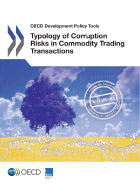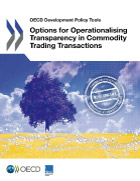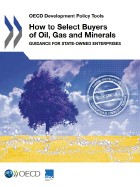Dialogue sur les politiques de développement axé sur les ressources naturelles
Thematic Dialogue on Commodity Trading Transparency
The Thematic Dialogue on Commodity Trading Transparency has developed five complementary and mutually supportive tools that home countries, trading companies and producing countries, including state-owned enterprises, can use to reduce drivers of corruption, and articulate complementary interventions in both producing countries and trading hubs. These tools have been developed as a package in order to address the multi-faceted dimensions of corruption in commodity trading, and in recognition of the roles of different actors in reducing the drivers of corruption, increasing transparency and ultimately improving accountability in commodity trading.
The Dialogue was launched following a call by the 2016 London Anti-Corruption Summit, and a high-level mandate received from the OECD Development Centre’s Governing Board on 3 October 2017. The multi-stakeholder dialogue platform fosters collaboration on addressing the global and multifaceted challenges of corruption in commodity trading, from both the supply and demand side.
Co-chairs: Nigeria and the United Kingdom
 Typology of Corruption Risks in Commodity Trading Transactions
Typology of Corruption Risks in Commodity Trading Transactions
Commodity trading presents specific and heightened risks of corruption due to the large amount of money involved in commodity trading transactions, which are source of important revenues for developing countries, and due to the sophisticated mechanisms used to channel corrupt payments. These include complex and opaque corporate structures, the use of offshore entities, that render the identification of beneficial owners more difficult, the use of intermediaries (including briefcase or shell companies) and joint ventures with politically exposed persons (PEPs).
This report maps out corruption risks of crosscutting relevance for the sales of oil, gas and minerals that arise at several points in commodity trading transactions. It contributes to advancing the global transparency and accountability agenda in commodity trading, by improving understanding and raising awareness of corruption red flags and evolving corruption patterns across a wide range of stakeholders, including home jurisdictions of commodity trading companies, trading hubs, host governments, state-owned enterprises and commodity trading companies.
 Options for Operationalising Transparency in Commodity Trading Transactions
Options for Operationalising Transparency in Commodity Trading Transactions
Given their magnitude, company payments for the purchase of oil, gas and minerals from governments or state-owned enterprises are of significant public interest. However, only a few commodity-trading companies regularly disclose such information. This report makes a case for a common global standard on transparency of payments that trading hubs, home governments and industry associations can use to ensure consistency, comparability and usability of data, building on the 2019 EITI Standard. Complementary measures by host governments and SOEs are necessary to set shared expectations across jurisdictions, including in producing countries. These include the adoption of disclosure policies, as well as the inclusion of disclosure obligations in commodity sales contracts to set clear expectations on transparency of payments, and avoid potential conflicting requirements and bilateral negotiations.
Online Stocktake of company reporting requirements applicable in different trading hubs
This online resource takes stock of current transparency, reporting and anti-corruption requirements across key global trading hubs. The aim is to determine whether payments to governments for the purchase of publicly owned commodities are subject to transparency requirements or reporting obligations in any of the key global trading hubs.
Online Mapping Tool of State-Owned Enterprises and their Subsidiaries
Despite implementing due diligence processes, companies involved in commodity trading face challenges in determining whether the seller they are dealing with is a State-owned enterprise (SOE). Although the Online Mapping Tool was conceived to support buyers in determining whether the seller they are dealing with is an SOE, its scope has been widened to all subsidiaries of selected SOEs, to increase the utility of the tool for a wider number of potential end-users. The pilot project maps ten SOEs and their subsidiaries from OECD and non-OECD countries, including Colombia, People’s Republic of China, Kazakhstan, Indonesia, Brazil, South Africa, Thailand and the Republic of the Congo.
How to Select Buyers of Oil, Gas and Minerals: Guidance for State-Owned Enterprises
The sale of publicly owned oil, gas and minerals can have a significant impact on the development trajectory of resource-rich developing and emerging economies. Getting the buyer selection process right is a crucial step to prevent potential public revenue losses arising from sub-optimal allocation and corruption. This policy tool is intended to strengthen SOEs’ capacity to market commodities and optimise the value of resources sold. It explains how they can set up transparent and competitive buyer selection procedures that reduce discretion, and close opportunities for favouritism and corruption, ultimately leading to increased revenues for improved development outcomes.
Back to the Policy Dialogue on Natural Resource-based Development (PD-NR) homepage
Documents connexes
